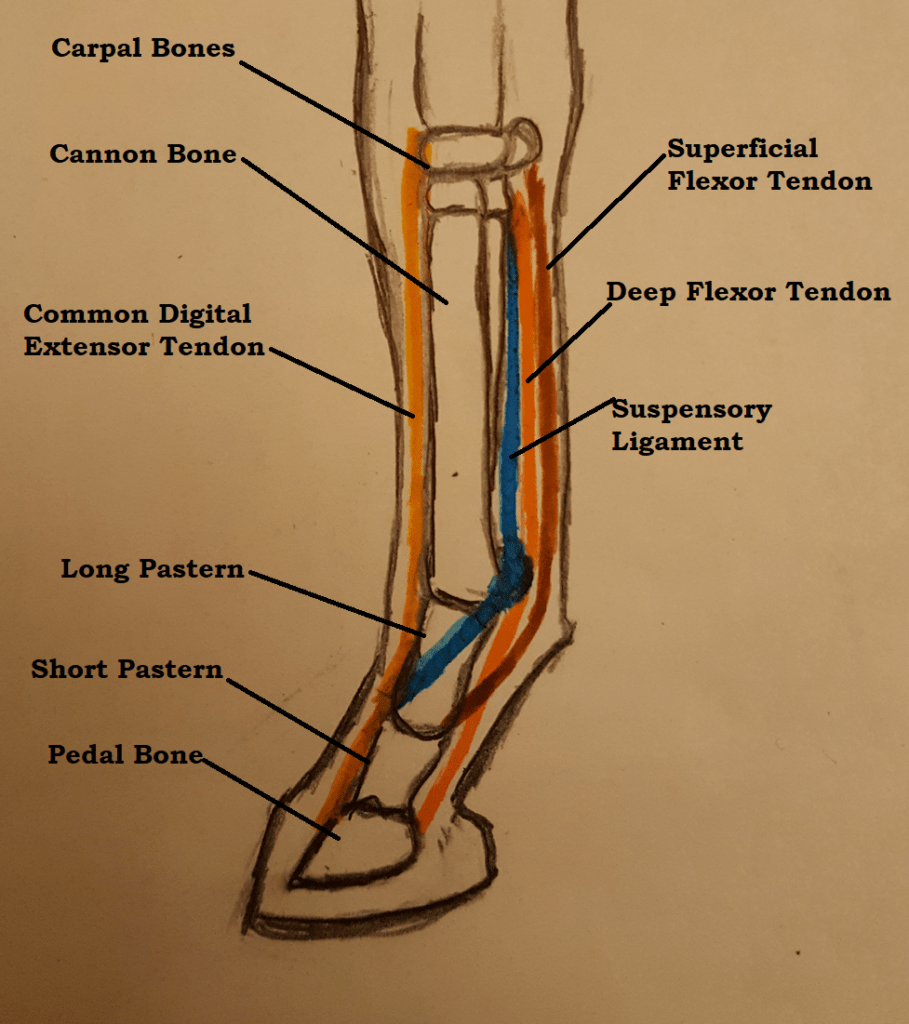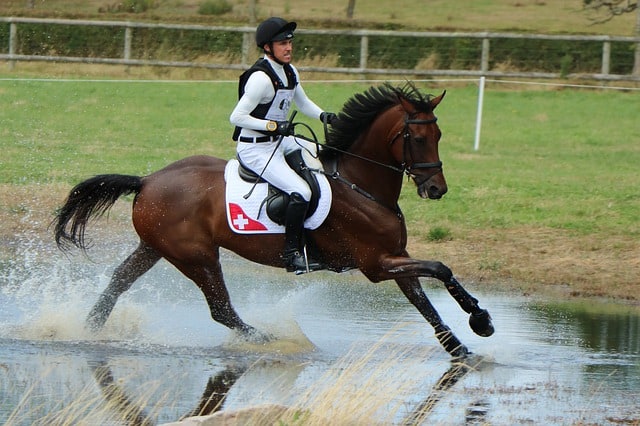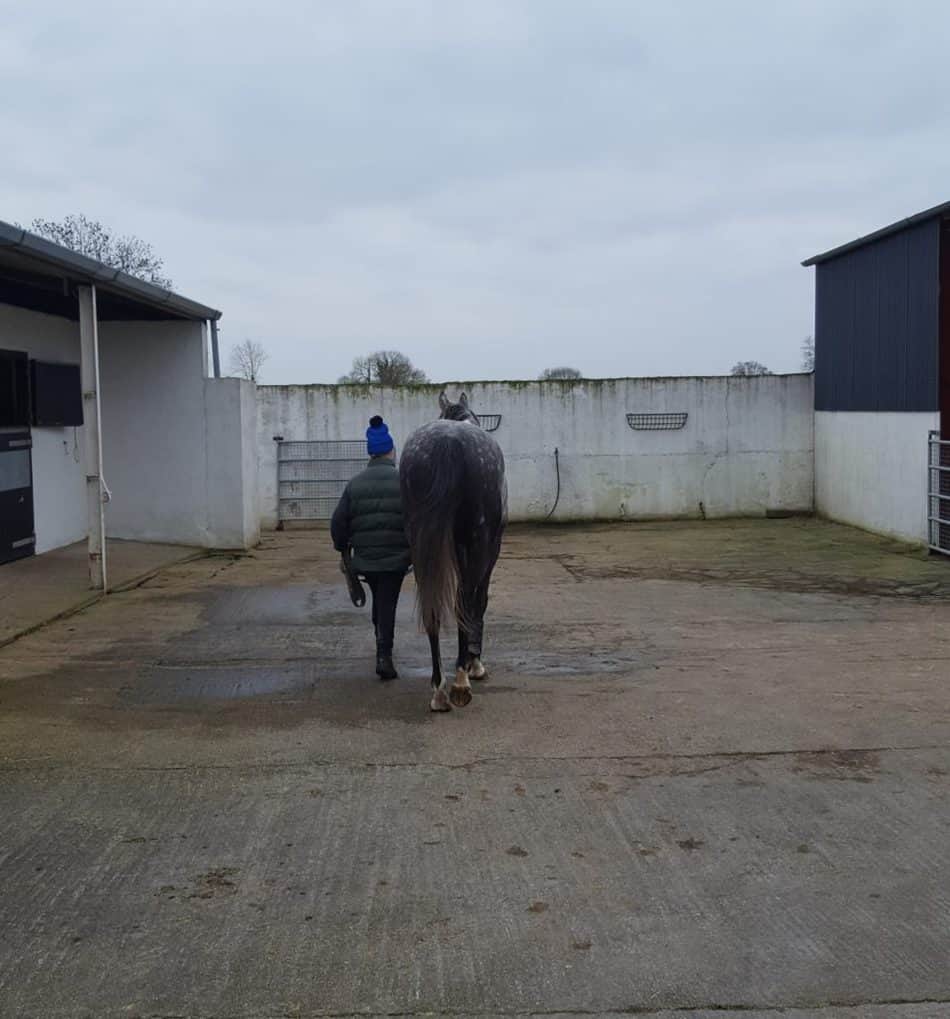The Suspensory Ligament plays such an important role in the horse’s locomotion, that it is no wonder that it becomes a site of injury in many competition horses. Therefore, it is very important for riders and trainers to be vigilant in the care and training of the horse so as to minimise the risk to this area, as injury can cause quite a lengthy convalescence, or possibly put an end to the horse’s sporting career. Let’s discover a little more about, the location, structure and function of this ligament, and what to look for if injury should occur.
Suspensory Ligament Structure and Function

The Suspensory ligament originates at the back of the knee in the horse; it then runs down the back of the metacarpal or cannon bone. On its descent it splits in two and each branch runs to one of the proximal sesamoid bones that are situated at the back of the fetlock joint. These branches of the ligament then move forward at the level of the first phalanx (area of pastern) where they join with the common digital extensor tendon.
The Suspensory ligament is quite elastic, as unlike other ligaments it contains some muscle tissue. This serves its function very well as it is constantly put under pressure, especially when a horse is moving at speed or jumping.
This ligaments primary function is to support the fetlock joint of the horse, preventing excessive extension at the joint (i.e. the fetlock dropping to the ground), during movement and at rest. The suspensory also plays an important role in the stay apparatus of the limb.
The stay apparatus is a group of muscles, tendons and ligaments in the forelimb and the hindlimb of the horse, that work together to lock the limbs in place which enables to the horse to sleep while standing, with the minimum expenditure of energy.
The Suspensory is assisted in its function of supporting the fetlock joint by both the superficial and deep flexor tendons which also play a major role in the stay apparatus of the limb.
Symptoms of Suspensory Injury in Horses.
When the horse has had an injury to the Suspensory it does not always cause severe lameness. Lameness can be slight and may only be visible after intensive work.
Depending on the site of the damage, there may be heat and slight swelling. At the top of the ligament, this can be difficult to pinpoint as much of the ligament is hidden under the flexor tendons and between both splint bones etc, but heat and swelling may be present toward the top of the tendons just below the knee. Injury to this part of the ligament is known as Proximal Suspensory Desmitis, and tends to have a better recovery rate.
Injury to the body of the Ligament is known as Body Suspensory Desmitis, and is more common in Race Horses and horses jumping at speed. Injury in this area will cause heat and swelling and tenderness, usually swelling will be felt at both sides of the tendon.
However often with the Suspensory, injury will take place lower down the leg, at the site where the ligament splits in to two, and can effect either branch of the ligament after it divides. There is usually heat and localised inflammation present, and the injured ligament is usually thickened, softer and tender, when the limb is lifted and the area examined. This type of injury is known as Branch Suspensory Desmitis.
In very severe cases, there may be a rupture of ligament leading to a drop in the level of the fetlock joint, the prognosis in such a case is not positive as recovery is rare.
Causes of Suspensory Ligament Injury.

The main animals affected by this type of injury are horses in fast work and sport horses i.e. those that are jumping, eventing and doing dressage.
Horses that are in fast work and are jumping at speed are definitely a higher risk for sustaining a suspensory injury. Also, allowing the animals feet to become over long, will put undue stress on the fetlock joint and therefore the suspensory ligament, predisposing it to injury. Plus horses with poor foot, or limb conformation can be at a higher risk of injury.
Treatment of Suspensory Injury.

Initially your vet will examine the horse, in an effort to pinpoint the area of injury; he may use nerve block and X-ray to rule out any bony involvement. If he suspects Suspensory, he will follow up with a scan to confirm his diagnosis.
Normally this would have been carried out with your standard Ultrasound Machine; however there is a new and improved type of Ultrasound known as UTC or Ultrasound Tissue Characterisation. This machine is able to distinguish between, damaged tissue, scar tissue and healthy fibres giving the Vet and the owner a better understanding as to the severity of the injury and what timescale will be involved in the healing and rehabilitation of the horse.
With UTC, it is recommended that you have regular scans throughout the healing process to determine the correct time to return the animal to work. This type of breakthrough in diagnostics is leading to reduced recurrence of injury once the horse has been returned to full work.
Care During the Initial Stages of a Suspensory Ligament Injury.
During the initial stages of the injury the basic protocol of Rest, Cold Hosing, and Poulticing with, a product such as Stay Sound or Leg Tend. This is followed by the application of stable bandages to both the injured leg and the opposite limb, to give the animal support.
Depending on the severity of the injury there may be a period of extended rest. If this is the case, the monotony of box rest can be broken up for the horse with time out of the stable for a pick of grass a couple of times a day in hand. In the past I have found this to be of great importance to keeping the animal happy during extended convalescence, but I always check with my Vet to make sure it won’t cause further damage, as in certain cases this may not be permitted.
Treatments for Suspensory Ligament Injury.
Laser & Ultrasound.
With Minor Injuries to the Ligament the Vet may recommend cold therapy such as cold hosing etc, Cold Laser and Therapeutic Ultrasound, to help initiate healing within the ligament.
Shockwave Therapy
Again for minor injuries to the Suspensory Ligament, a course of Shockwave Therapy has been used very successfully by Vets. This therapy uses high energy acoustic waves to promote tissue regeneration and cell repair, reduce pain, and improve flexibility.
Surgery.
With severe injuries, surgery may be required, such as with branch injury avulsion in which one of the proximal sesamoids has been damaged/fractured during the injury, or to remove blood clots which would limit recovery. With this type of treatment, there is a lengthy box rest followed by very slow and steady recovery program. Prognosis is not always positive.
Stem Cell Therapy.
The successful use of Stem Cell Therapy has been reported as having a very high success rate in treating soft tissue injuries in horse. The therapy is delivered via one injection to the injury site guided by ultra sound. The stem cells promote healing and tissue regeneration and also have anti-inflammatory properties.
Recovery Program.
Regardless of the severity of the injury there will always be a recovery program. With minor Suspensory Injuries, a period of approximately 3 months box rest followed by a gradual recovery program, beginning with in hand work.
For more severe injuries there may be a lengthier box rest followed by a steady recovery program and return to work would take approximately 6 to 12 months.
All recovery programs will be tailored to the individual needs of the horse and the severity of the Suspensory Injury. Usually walking in hand for a few minutes twice daily may be the initial program, building gradually day by day, until the animal gradually progresses to ridden work, and slowly to full work.
Conclusion.
Suspensory injury is very serious and can potentially end your horses sporting career. With regular visits from your farrier, this will ensure that your horse’s feet are kept well balanced and do not become over long, reducing stress on the area.
Correct fittening of the horse is also of great importance, and will ensure that the horse is fit for the work being required of them.
As with all sports there is always a risk of injury, if your horse should sustain a suspensory injury, early diagnosis and treatment followed by slow recovery program is the best option for his return to full work.
References: Smythe & Goody – Horse Structure & Movement – Horace Hayes – Veterinary Notes for Horse Owners
Kainer & McCracken – Horse Anatomy A Colouring Atlas www.equinetendon.com www.medrigo.com www.vcahospitals.com
This Article was originally published in the January 2020 Issue of Irish Sport Horse Magazine.
